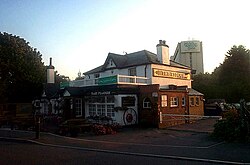Sipson: Difference between revisions
m clean up, typos fixed: buit → built |
|||
| Line 29: | Line 29: | ||
During the Georgian period the Bath Road was busy with coaches. The greater part of the coach trade went on to [[Colnebrook]] a few miles on. | During the Georgian period the Bath Road was busy with coaches. The greater part of the coach trade went on to [[Colnebrook]] a few miles on. | ||
Fairley Aviation | Fairley Aviation built their Great West Aerodrome just to the south of Sibson in 1930, by the hamlet of Heath Row. Later, in 1944, a majotr new airport was begun there, and Heath Row was demolished to make way for it; events which inspired a poem from John Wild in 1944, named "A Lament to Heathrow". As the airport grew, the dynamics of the area changed. | ||
===Heathrow expansion=== | ===Heathrow expansion=== | ||
Latest revision as of 13:49, 28 January 2016
| Sipson | |
| Middlesex | |
|---|---|
 The Plough Inn, Sipson | |
| Location | |
| Grid reference: | TQ075785 |
| Location: | 51°29’42"N, 0°27’2"W |
| Data | |
| Post town: | West Drayton |
| Postcode: | UB7 |
| Dialling code: | 020 |
| Local Government | |
| Council: | Hillingdon |
| Parliamentary constituency: |
Hayes and Harlington |
Sipson is a village in Middlesex, sitting in the southwest of the county, near the northern perimeter of Heathrow Airport, which airport is an important economic factor in the village but also its greatest threat.
Sipson village adjoins the famous "Bath Road" (whose route has been inherited by the modern A4). The road linked London to Bath in Somerset. The road still runs along the southern edge of the village, now broader and busier than ever with traffic coming into and out of Middlesex but also to and fro from the airport and the many hotels which line the route.
The nearest village to Sipson is Harmondsworth to the west. West Drayton and Yiewsley are close by to the north, and Harlington to the east.
Name of the village
The name of Sibson comes from the Old English language, originally Sibbwines tun, meaning "Sibbwine's estate / farmstead".
History
Sibson has a long history, much predating even the ancient stones of its parish church. It was a thriving farming village during the Anglo-Saxon period, though it escapes mention in the Domesday Book of 1086 as it was part of the manor of Harmondsworth (Hermodesworde), one of the more lively entries. It was an estate held by Harold Godwinesson (later King Harold II) and passed to the King after the Normans came.
During the Georgian period the Bath Road was busy with coaches. The greater part of the coach trade went on to Colnebrook a few miles on.
Fairley Aviation built their Great West Aerodrome just to the south of Sibson in 1930, by the hamlet of Heath Row. Later, in 1944, a majotr new airport was begun there, and Heath Row was demolished to make way for it; events which inspired a poem from John Wild in 1944, named "A Lament to Heathrow". As the airport grew, the dynamics of the area changed.
Heathrow expansion
On 10 January 1946 the British Cabinet agreed Stage 3 of the airport, which was an extension north of the Bath Road, with a large triangle of 3 runways, obliterating Sipson and most of Harlington, and diverting the Bath Road.[1] It was not carried out.
As the Twenty-first century dawned, the owner of Heathrow, BAA plc, expressed a desire to expand their airport with a third runway, which would require compulsory purchase orders to seized and demolish the village of Sipson, which stands where they wanted to put the new runway.
In 2009 the threat became immediate as the Labour government of the time agreed to co-operate with BAA plc to take over and demolish the village.[2][3] The actress Emma Thompson and other bought land around Sipson in 2009 with a view to preventing the expansion of Heathrow Airport. However, in March 2010 the High Court, in a judicial review, ruled that the plans must be reconsidered on environmental grounds,[4] and soon afterwards came a general election. The ensuing Conservative-Liberal coalition government announced in May 2010 that the third runway plan had been cancelled.[5] Nevertheless, BAA plc remain active in lobbying and in buying houses in the village to remove opposition.
References
- ↑ Sherwood 2009, p87
- ↑ "Transport Secretary's statement to the House of Commons, 15th January 2009". Department of Transport. http://www.dft.gov.uk/press/speechesstatements/statements/infrastructure. Retrieved 2009-01-16.
- ↑ "New runway will demolish village". BBC News. 2009-01-15. http://news.bbc.co.uk/2/hi/uk_news/england/london/7830275.stm. Retrieved 2009-01-15.
- ↑ Bowcott, Owen (2010-03-26). "Heathrow protesters win third runway court victory". The Guardian (London). http://www.guardian.co.uk/environment/2010/mar/26/heathrow-third-runway-travel-and-transport.
- ↑ "Heathrow runway plans cancelled". BBC News. 2010-05-12. http://news.bbc.co.uk/1/hi/england/london/8678282.stm.
Outside links
- Images of buildings in Sipson
- Heathrow Villages – Sipson
- Transition Heathrow activist group
- The Guardian newspaper article

This Middlesex article is a stub: help to improve Wikishire by building it up.